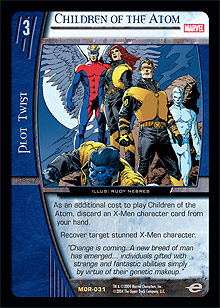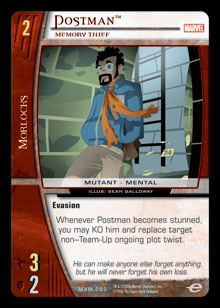
The evasion mechanic was originally the brainchild of the Mandel-murdering Morlock Hump . . . herys. There were two central components to the initial creation of what would become the evasion keyword. The first was R&D’s desire to create a way to allow players to protect characters from attacks in exchange for a certain cost.
From the beginning, we had a healthy amount of design space to play a character’s power against its combat values. Meaning, we could give a character a power that was stronger than what similarly costed characters had at the balancing expense of lowering its ATK and/or DEF values. What we wanted was a new design component that would allow us to create characters that had powers that supported both themselves and allied characters at the expense of making and receiving attacks on select turns.
While players could naturally control whether their characters attacked or not on their initiative, they had little control beyond formation to protect those characters on the opponent’s initiative. So the question became, how could we create interesting characters with support-based powers that could safely survive into the later turns of the game?
 We knew from the Marvel Origins set that cards that allowed for recovery effects could generate this play pattern, so this was the first direction we looked at. Recovery was an acceptable answer, but cards like Children of the Atom provided the additional effect of recovering the character inside the combat phase. This resulted in having an extra defender for the turn, and that was outside the balance level of what we wanted to accomplish with the new mechanic.
We knew from the Marvel Origins set that cards that allowed for recovery effects could generate this play pattern, so this was the first direction we looked at. Recovery was an acceptable answer, but cards like Children of the Atom provided the additional effect of recovering the character inside the combat phase. This resulted in having an extra defender for the turn, and that was outside the balance level of what we wanted to accomplish with the new mechanic.
Another problem with using support cards to generate the recovery effects was that it ended up using a lot of space in a deck and was directly tied into the team’s mechanical identity (in this case, the X-Men). We knew that while one new team would end up being “the” evasion team, we wanted the keyword to appear on characters from multiple teams. This meant that we needed to capture the recovery component as part of the keyword rather than as plot twist and location support cards.
So, we knew we wanted players to recover and we knew we wanted it to happen outside the combat phase. The last step was to determine the cost for allowing the character to safely side-step combat for a turn. In early testing of the mechanic, we tried allowing characters to use the power for no cost. Initially, we thought that the extra direct endurance loss the evading character’s controller would take would balance against having additional board control on later turns. This turned out to be a little too good.
We also needed to pick the visual representation of what an evaded character would look like. Formations were the biggest issue here. We didn’t want the evaded character to have any impact on combat. Reviewing what already existed in the game, we knew that stunned characters were already doing this. By placing an evaded character face down, we could show that it had evaded, and it could use the same non-combat interference rules as stunned characters. That led to the final mechanical component of the keyword—making the cost to evade involve stunning the character. This provided the board presentation/interaction and a reasonable cost for the ability.
The second component was identifying the team that would become the natural home for the mechanic. Looking at Spider-Man himself, his power set was a natural fit for the evasion mechanic. He isn’t bulletproof or invulnerable. He survives by avoiding attacks through superior agility, entangling his opponents in webs, or using his Spider Senses. In essence, his power set allows him to get out of the way, and that was what we wanted evasion to represent. As the central hero of the Spider-Friends, he would be setting the design identity for the team. This was how the evasion mechanic found its original home with the Spider-Friends.
Skipping ahead five sets, we found ourselves bringing back old teams for the first time. By extension, we had to ask ourselves, “Should we be bringing back old mechanics, as well?” In our more recent releases, we’ve trended toward carrying over new mechanics more frequently into the newest set. Concealed, concealed–optional, willpower, leader, and reservist have all had strong appearances in later sets. This had us looking at the year-one mechanics that never made a splash in later sets like some of the newer keywords had.
The evasion ability quickly hit the top of our list. When we had decided on the Morlocks team, a number of people believed that they would be a natural home for re-featuring the evasion mechanic. It was an excellent thematic fit for a group of outcasts who actively tried to avoid contact with the outside world. Originally, I had wanted the Morlocks to be the central concealed team for the set, as I thought that mechanic better spoke to their hiding in the shadows. After seeing how concealed could also be used to represent the behind-the-scenes machinations of the Hellfire Club, however, I was quickly convinced that they should be the central concealed team of the set. I did manage to get a few of the “It’s a trap!” concealed mechanics on a number of the Morlocks, and the “beat stick” Morlocks could pay a resource to move to the hidden area, so in the end, I got everything I wanted anyway.
It’s good to be the boss.
With that decision made, I needed to determine how evasion was going to be different for the Morlocks as compared to the Spider-Friends. As a new mechanic in the Spider-Man set, a good number of the evasion support effects revolved around the board control elements that the keyword enabled. Cards like Ezekiel rewarded players for having more characters in the late game, which the evasion characters allowed for.
 For the Morlocks, I wanted to do something different. One of the elements of evasion I noticed was that it let you proactively stun your character when it wasn’t in combat. This allowed for a plot twist–speed “trigger” that could be manipulated by the evasion character’s controller. That led me to create cards like Artie, Leech, and Postman. These characters can use evasion to trigger their powers outside of combat, allowing for a greater degree of control.
For the Morlocks, I wanted to do something different. One of the elements of evasion I noticed was that it let you proactively stun your character when it wasn’t in combat. This allowed for a plot twist–speed “trigger” that could be manipulated by the evasion character’s controller. That led me to create cards like Artie, Leech, and Postman. These characters can use evasion to trigger their powers outside of combat, allowing for a greater degree of control.
The ability to control when your characters become stunned also allows you to control the number of stunned characters you have in play at any given time. This was the second new design focus for evasion—rewarding players with effects that looked for the number of stunned characters they controlled. This opened up a number of interesting play decisions, as players now needed to evaluate whether it was better to evade a character to enhance the power of these support effects, or whether the right decision was not to evade, trying to stun an opposing character through normal combat instead.
With the addition of other support effects from characters like Storm, Electric Eve, and Healer, a Morlocks evasion deck had all the tools and tricks it needed to be a tournament contender. Cards like Bloodhound and Brave New World would also allow players the flexibility of building a Morlocks/Spider-Friends evasion Team-Up deck that would grant access to a number of powerful old-school support cards like Spider Senses, Sticky Situation, and Nice Try!.
On a final note, the R&D team is always looking for new ways to allow players to interact with the direction of the game. We are currently looking at running online polls that would allow players to vote on questions related to future sets. Evasion was the first mechanic we brought back, and we’re looking at others for upcoming expansions. What mechanics would you like to see again? Put some thought into that and keep an eye out for a poll on the topic in the near future.